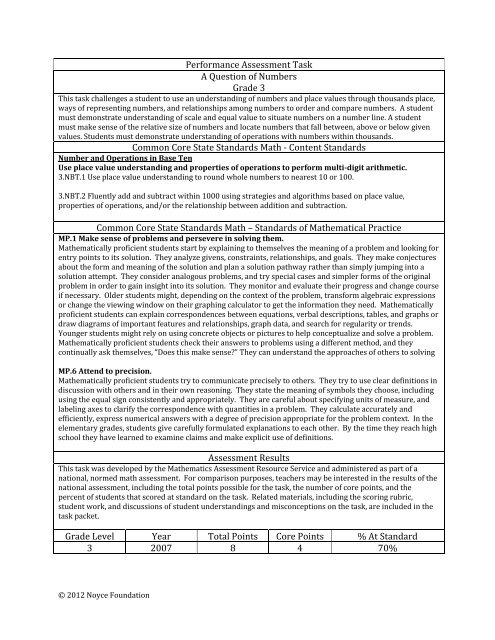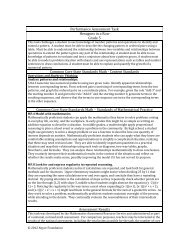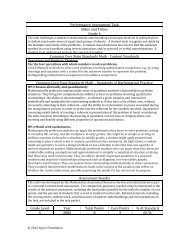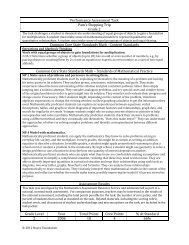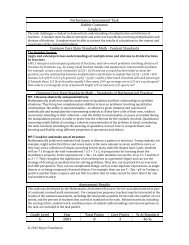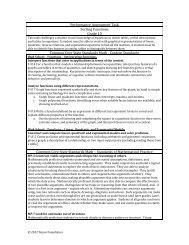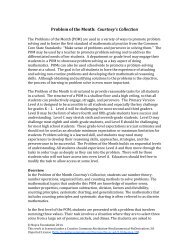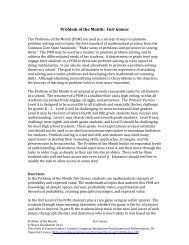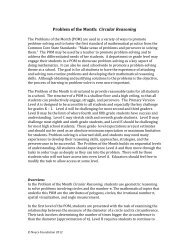Performance Assessment Task A Question of Numbers Grade 3 ...
Performance Assessment Task A Question of Numbers Grade 3 ...
Performance Assessment Task A Question of Numbers Grade 3 ...
- No tags were found...
You also want an ePaper? Increase the reach of your titles
YUMPU automatically turns print PDFs into web optimized ePapers that Google loves.
<strong>Performance</strong> <strong>Assessment</strong> <strong>Task</strong><br />
A <strong>Question</strong> <strong>of</strong> <strong>Numbers</strong><br />
<strong>Grade</strong> 3<br />
This task challenges a student to use an understanding <strong>of</strong> numbers and place values through thousands place,<br />
ways <strong>of</strong> representing numbers, and relationships among numbers to order and compare numbers. A student<br />
must demonstrate understanding <strong>of</strong> scale and equal value to situate numbers on a number line. A student<br />
must make sense <strong>of</strong> the relative size <strong>of</strong> numbers and locate numbers that fall between, above or below given<br />
values. Students must demonstrate understanding <strong>of</strong> operations with numbers within thousands.<br />
Common Core State Standards Math - Content Standards<br />
Number and Operations in Base Ten<br />
Use place value understanding and properties <strong>of</strong> operations to perform multi-digit arithmetic.<br />
3.NBT.1 Use place value understanding to round whole numbers to nearest 10 or 100.<br />
3.NBT.2 Fluently add and subtract within 1000 using strategies and algorithms based on place value,<br />
properties <strong>of</strong> operations, and/or the relationship between addition and subtraction.<br />
Common Core State Standards Math – Standards <strong>of</strong> Mathematical Practice<br />
MP.1 Make sense <strong>of</strong> problems and persevere in solving them.<br />
Mathematically pr<strong>of</strong>icient students start by explaining to themselves the meaning <strong>of</strong> a problem and looking for<br />
entry points to its solution. They analyze givens, constraints, relationships, and goals. They make conjectures<br />
about the form and meaning <strong>of</strong> the solution and plan a solution pathway rather than simply jumping into a<br />
solution attempt. They consider analogous problems, and try special cases and simpler forms <strong>of</strong> the original<br />
problem in order to gain insight into its solution. They monitor and evaluate their progress and change course<br />
if necessary. Older students might, depending on the context <strong>of</strong> the problem, transform algebraic expressions<br />
or change the viewing window on their graphing calculator to get the information they need. Mathematically<br />
pr<strong>of</strong>icient students can explain correspondences between equations, verbal descriptions, tables, and graphs or<br />
draw diagrams <strong>of</strong> important features and relationships, graph data, and search for regularity or trends.<br />
Younger students might rely on using concrete objects or pictures to help conceptualize and solve a problem.<br />
Mathematically pr<strong>of</strong>icient students check their answers to problems using a different method, and they<br />
continually ask themselves, “Does this make sense?” They can understand the approaches <strong>of</strong> others to solving<br />
MP.6 Attend to precision.<br />
Mathematically pr<strong>of</strong>icient students try to communicate precisely to others. They try to use clear definitions in<br />
discussion with others and in their own reasoning. They state the meaning <strong>of</strong> symbols they choose, including<br />
using the equal sign consistently and appropriately. They are careful about specifying units <strong>of</strong> measure, and<br />
labeling axes to clarify the correspondence with quantities in a problem. They calculate accurately and<br />
efficiently, express numerical answers with a degree <strong>of</strong> precision appropriate for the problem context. In the<br />
elementary grades, students give carefully formulated explanations to each other. By the time they reach high<br />
school they have learned to examine claims and make explicit use <strong>of</strong> definitions.<br />
<strong>Assessment</strong> Results<br />
This task was developed by the Mathematics <strong>Assessment</strong> Resource Service and administered as part <strong>of</strong> a<br />
national, normed math assessment. For comparison purposes, teachers may be interested in the results <strong>of</strong> the<br />
national assessment, including the total points possible for the task, the number <strong>of</strong> core points, and the<br />
percent <strong>of</strong> students that scored at standard on the task. Related materials, including the scoring rubric,<br />
student work, and discussions <strong>of</strong> student understandings and misconceptions on the task, are included in the<br />
task packet.<br />
<strong>Grade</strong> Level Year Total Points Core Points % At Standard<br />
3 2007 8 4 70%<br />
© 2012 Noyce Foundation
A <strong>Question</strong> <strong>of</strong> <strong>Numbers</strong><br />
This problem gives you the chance to:<br />
• show you can compare and order numbers<br />
Holly’s class is learning about big numbers.<br />
1. Here is part <strong>of</strong> the class number line.<br />
650 660<br />
Put an X on the number line, on the place that is halfway between 650 and 660.<br />
What is the number that should be there?<br />
_______________<br />
2. Holly knows a pony weighs between 365 pounds and 425 pounds.<br />
Write a possible number for the weight <strong>of</strong> a pony. ______________ pounds<br />
3. The activity center swimming pool holds between 1,875 gallons and 1,940 gallons<br />
<strong>of</strong> water.<br />
Write a possible number for the amount <strong>of</strong> water<br />
the swimming pool holds.<br />
______________ gallons<br />
4. A school computer could cost between $2,950 and $3,055.<br />
Give three possible prices for the computer.<br />
$ _______________ $ _______________ $ _______________<br />
Copyright © 2007 by Mathematics <strong>Assessment</strong> 96 A <strong>Question</strong> <strong>of</strong> <strong>Numbers</strong> Test 3<br />
Resource Service. All rights reserved.
5. The American Revolution started in 1775 and finished in 1783.<br />
In which year was it halfway through?<br />
_________________<br />
Show how you know using this number line.<br />
1770 1780 1790<br />
6. Holly’s teacher says the school library has 1000 books.<br />
Holly thinks that the library may have 40 more books.<br />
What is the greatest number <strong>of</strong> books that the library could have? __________<br />
Show how you figured this out.<br />
Tom thinks that the library may have 40 fewer books than 1000.<br />
What is the smallest number <strong>of</strong> books that the library could have? ____________<br />
Show how you figured this out.<br />
8<br />
Copyright © 2007 by Mathematics <strong>Assessment</strong> 97 A <strong>Question</strong> <strong>of</strong> <strong>Numbers</strong> Test 3<br />
Resource Service. All rights reserved.
<strong>Task</strong> 5: A <strong>Question</strong> <strong>of</strong> <strong>Numbers</strong><br />
•<br />
• The core elements <strong>of</strong> performance required by this task are:<br />
• • show you can compare and order numbers<br />
•<br />
Based on these, credit for specific aspects <strong>of</strong> performance should be assigned as follows<br />
Rubric<br />
points<br />
section<br />
points<br />
1. Gives correct answer: 655<br />
1<br />
Draws an X in the correct place on the number line.<br />
1 2<br />
2. Gives correct answer such as: 380 pounds. 1<br />
1<br />
3 Gives correct answer: such as 1,920 gallons. 1<br />
Gives correct answers such as: $2955 $3000 $3053<br />
4.<br />
1<br />
1<br />
1<br />
5 Gives correct answer: 1779 and<br />
Marks the correct year on the number line.<br />
6. Gives correct answer: 1040 and<br />
Shows 1000 + 40<br />
Gives correct answer: 960 and<br />
Shows 1000 - 40<br />
1 2<br />
Total Points 8<br />
1<br />
1<br />
1<br />
Copyright © 2007 by Mathematics <strong>Assessment</strong> 98 A <strong>Question</strong> <strong>of</strong> <strong>Numbers</strong> Test 3<br />
Resource Service. All rights reserved.
A <strong>Question</strong> <strong>of</strong> <strong>Numbers</strong><br />
Work the task and look at the rubric. What do are the big mathematical ideas being assessed by this<br />
task?<br />
In part 1, students were asked to use a number line to find a number between 650 and 660. How<br />
many <strong>of</strong> your students put:<br />
655 mark<br />
on # line<br />
655 no mark<br />
on # line<br />
655.5 656 651 1310 Other<br />
Think about each <strong>of</strong> these mistakes. How are they showing different misunderstandings about<br />
number and place value?<br />
To work parts 2,3,and 4 students had to think about several things. What does between mean?<br />
Should I do a computation? How do I make a number larger or smaller? In looking at place value,<br />
Liping Ma and Kathy Richards talk about numbers going around ten, numbers going around<br />
hundreds, and numbers going around a thousand. Look carefully at how your students thought about<br />
these ideas. How many <strong>of</strong> your students:<br />
Correct Answers<br />
Misunderstood<br />
“between”<br />
Put in the end<br />
values<br />
Added or<br />
subtracted the two<br />
numbers<br />
Values for part 4<br />
were too high or<br />
too low<br />
Other<br />
Now look at work for part 5. Have your students worked with number lines? If they haven’t<br />
worked with number lines, what other strategies could they use to make sense <strong>of</strong> the problem?<br />
Look at student work.<br />
1179 1779, but no<br />
use <strong>of</strong> number<br />
line<br />
1778 1780 1775/1790 Other<br />
Did students have trouble drawing the scale?<br />
Did students have trouble counting marks instead <strong>of</strong> spaces?<br />
What other misconceptions did you see?<br />
What are some ways that you could incorporate use <strong>of</strong> the number line in warm ups? Problemsolving?<br />
Number talks? How does the number line help to develop a deeper understanding <strong>of</strong> place<br />
value? Of number sense? Of how the base-ten system is built?<br />
Finally look at work for part 6. Did students know to add and subtract? Did they pick 1000 for<br />
most and 40 for least? When subtracting what types <strong>of</strong> place-value understanding errors did you<br />
see?<br />
3 rd grade - 2007<br />
Copyright © 2007 by Noyce Foundation 99<br />
Resource Service. All rights reserved.
Looking at Student Work on A <strong>Question</strong> <strong>of</strong> <strong>Numbers</strong><br />
Student A is able to use the number line to find numbers within a given range or to divide a range<br />
halfway. The student understands the mathematical use <strong>of</strong> the word between and uses landmark or<br />
friendly numbers to name values between. Notice how Student A puts all the values on the number<br />
line, identifies the section being considered, then labels the midpoint.<br />
Student A<br />
3 rd grade - 2007<br />
Copyright © 2007 by Noyce Foundation 100<br />
Resource Service. All rights reserved.
Student A, part 2<br />
3 rd grade - 2007<br />
Copyright © 2007 by Noyce Foundation 101<br />
Resource Service. All rights reserved.
Student B uses the number line as a tool. See the marking <strong>of</strong>f <strong>of</strong> equal distances to locate the<br />
midpoint in part 1. The student sees the number line as a series <strong>of</strong> numbers between two end points,<br />
but has not quite mastered how to scale in all the values or measure in equal units. (See part 5. The<br />
student is trying to count backwards to the middle, but makes a stumble. The student has a very<br />
clear, clean explanation for finding the most and least books.<br />
Student B<br />
3 rd grade - 2007<br />
Copyright © 2007 by Noyce Foundation 102<br />
Resource Service. All rights reserved.
Student B, part 2<br />
3 rd grade - 2007<br />
Copyright © 2007 by Noyce Foundation 103<br />
Resource Service. All rights reserved.
This idea <strong>of</strong> measuring <strong>of</strong>f equal units or scaling the number line was difficult for students. Notice<br />
Student C attempted the idea and then simplified the number line to just the relevant numbers.<br />
Student D was able to think about the locations for starting and ending numbers and then put in the<br />
appropriate midpoint without counting every number. Student E combines measuring equal units,<br />
with marking <strong>of</strong>f the starting, ending and midpoints.<br />
Student C<br />
Student D<br />
Student E<br />
3 rd grade - 2007<br />
Copyright © 2007 by Noyce Foundation 104<br />
Resource Service. All rights reserved.
Student F may or may not have had experience with a number line, but is able to use other strategies<br />
to find the midpoint. Then Student F is able to estimate the location <strong>of</strong> that value on the number<br />
line. Notice the full explanation for finding the values in part 6.<br />
Student F<br />
3 rd grade - 2007<br />
Copyright © 2007 by Noyce Foundation 105<br />
Resource Service. All rights reserved.
Student G tries to use subtraction to find the midpoint. But does not use that information to find the<br />
midpoint. How could the “8” be used to find the midpoint? What would be the next step(s)? Notice<br />
how the student uses place value units to find the total number <strong>of</strong> books in the library.<br />
Student G<br />
3 rd grade - 2007<br />
Copyright © 2007 by Noyce Foundation 106<br />
Resource Service. All rights reserved.
Student H is able to measure the scale and locate the endpoints for the war, but doesn’t count <strong>of</strong>f the<br />
spaces to locate an exact midpoint. Notice that student H seems to understand the concept <strong>of</strong> ± 40,<br />
but has further work <strong>of</strong> finding values within the range <strong>of</strong> possibility.<br />
Student H<br />
3 rd grade - 2007<br />
Copyright © 2007 by Noyce Foundation 107<br />
Resource Service. All rights reserved.
Some students are having difficulty applying ideas about place value to computation. Student I has<br />
4 points on page 1 <strong>of</strong> the task, but lines up thousands and tens when adding and subtracting. Student<br />
J puts the 4 tens in the hundreds column. Student K and L have trouble with place value which leads<br />
to procedural errors in using the standard algorithm. Notice Student K also has trouble thinking<br />
about what comes after 1778.<br />
Student I<br />
Student J<br />
3 rd grade - 2007<br />
Copyright © 2007 by Noyce Foundation 108<br />
Resource Service. All rights reserved.<br />
Student K
Student L<br />
3 rd grade - 2007<br />
Copyright © 2007 by Noyce Foundation 109<br />
Resource Service. All rights reserved.
Understanding mathematical terminology or academic language is <strong>of</strong>ten different from common<br />
word usage. Student M relies too heavily on finding and circling key words, rather than teasing out<br />
what is being asked in the question. In this particular problem, “and” does not mean the combining<br />
<strong>of</strong> two values, but is identifying two points that are similar because that represent endpoints.<br />
Student M<br />
3 rd grade - 2007<br />
Copyright © 2007 by Noyce Foundation 110<br />
Resource Service. All rights reserved.
Student N has trouble distinguishing between the number with the greatest absolute value and<br />
adding more books to obtain the greatest possible value. This example shows the subtleties required<br />
for reading academic material.<br />
Student N<br />
3 rd grade - 2007<br />
Copyright © 2007 by Noyce Foundation 111<br />
Resource Service. All rights reserved.
3 rd <strong>Grade</strong> <strong>Task</strong> 5 A <strong>Question</strong> <strong>of</strong> <strong>Numbers</strong><br />
Student <strong>Task</strong><br />
Core Idea 1<br />
Number<br />
Properties<br />
Compare and order numbers using values and number lines. Make a<br />
reasonable argument to find the midpoint <strong>of</strong> a range <strong>of</strong> numbers.<br />
Understand numbers, ways <strong>of</strong> representing numbers, relationships<br />
among numbers and number systems.<br />
• Develop understanding <strong>of</strong> the relative magnitude <strong>of</strong> whole<br />
numbers and the concepts <strong>of</strong> sequence, quantity, and the relative<br />
positions <strong>of</strong> numbers.<br />
Mathematics in this task:<br />
• Ability to measure in equal size units on a number line<br />
• Ability to count around tens, hundreds, and thousands<br />
• Ability to find a numerical midpoint and to find and compare numbers within a range<br />
• Understand most and least in the mathematical sense <strong>of</strong> ± 40.<br />
Based on teacher observations, this is what third graders knew and were able to do:<br />
• Find and name the middle number on a number line (part 1) when the scale marks are drawn<br />
in<br />
• Find the most books that could be in a library<br />
• Find points between two numbers<br />
Areas <strong>of</strong> difficulty for students:<br />
• Subtracting from 1000<br />
• Finding a midpoint between two numbers on a number line, when the intervals are not<br />
marked and the endpoints for the task are different from the endpoints on a number line<br />
• Marking <strong>of</strong>f equal intervals, dividing something into ten parts<br />
• Understanding that between does not include the endpoints<br />
3 rd grade - 2007<br />
Copyright © 2007 by Noyce Foundation 112<br />
Resource Service. All rights reserved.
The maximum score available for this task is 8 points.<br />
The minimum score needed for a level 3 response, meeting standard, is 4 points.<br />
Most students, about 87%, could find and name the midpoint on a scaled number line. Many<br />
students, about 71%, could locate the midpoint on a number line, and find values between two<br />
endpoints (parts 2 and 3). More than half, 58%, could also find three values between two endpoints.<br />
26% could also find solutions for thinking about the most and least books in the library. 8% could<br />
meet all the demands <strong>of</strong> the task including scaling their own number line to find a midpoint where<br />
the endpoints were not the ends <strong>of</strong> the number line. 7% <strong>of</strong> the students scored no points on this task.<br />
Only 38% <strong>of</strong> those students attempted the task.<br />
3 rd grade - 2007<br />
Copyright © 2007 by Noyce Foundation 113<br />
Resource Service. All rights reserved.
A <strong>Question</strong> <strong>of</strong> <strong>Numbers</strong><br />
Points Understandings Misunderstandings<br />
0 38% <strong>of</strong> the students attempted<br />
the task.<br />
Time may have been an issue for many students.<br />
Some students struggled in trying to find the midpoint<br />
between 650 and 660 on the number line. 7.5% <strong>of</strong> the<br />
students marked 656. Some students thought the<br />
number was 655.5. Students may have been counting<br />
2 Students could mark and name<br />
the midpoint between 650 and<br />
660.<br />
4 Students find a midpoint on a<br />
number line and give values<br />
between two endpoints. (parts 2<br />
and 3)<br />
6 Students could find midpoints,<br />
locate values in between two<br />
endpoints (parts 2,3, and 5), and<br />
find the most books that could be<br />
located in the library.<br />
7 Students could find midpoints,<br />
locate values in between two<br />
endpoints, and find the most and<br />
the least books that could be<br />
located in the library.<br />
8 Students could find midpoints,<br />
locate values in between two<br />
endpoints, and find the most and<br />
the least books that could be<br />
located in the library. Students<br />
could also mark in intervals on a<br />
number line and use it to find the<br />
midpoint between two numbers,<br />
which were not the endpoints on<br />
the number line.<br />
lines instead <strong>of</strong> spaces to count <strong>of</strong> the distance.<br />
Students had difficulty interpreting between in parts 2<br />
and 3. 7.5% gave endpoints instead. 3% added the<br />
endpoints.<br />
Students had difficulty naming three values between<br />
two endpoints. Almost 18% gave at least one value<br />
that was above the highest endpoint. 15% gave values<br />
that were too low. 5% included one or both endpoints.<br />
About 7% gave the correct answer for most, but<br />
showed no calculations or explanation. 7% thought<br />
the answer for most was 1000 because it was the<br />
greatest number in the problem. Some students had<br />
difficulty with place value, getting answers like 5000<br />
or 1400. Students had even more difficulty with the<br />
subtraction (1000-40). 4% had the correct answer but<br />
no work. 6% thought the answer was 40. 6% had<br />
place value errors getting either 60 or 600. Others had<br />
place value errors like 3000, 996, or 9504.<br />
Students had difficulty using a number line to find a<br />
midpoint when there was no scale. They could figure<br />
out how to divide the sections into 10 equal parts and<br />
may have only put 2 or intervals. 21% picked 1780,<br />
the middle <strong>of</strong> the given number line but not the middle<br />
<strong>of</strong> the war(1775 to 1783). 7.5% knew the midpoint<br />
was 1779, but used the number line incorrectly or did<br />
not use the number line. 5% thought the midpoint was<br />
1778. 5% thought the midpoint was 1775 (midpoint<br />
for left half <strong>of</strong> the number line). 4% picked one <strong>of</strong> the<br />
endpoints on the given number line.<br />
3 rd grade - 2007<br />
Copyright © 2007 by Noyce Foundation 114<br />
Resource Service. All rights reserved.
Implications for Instruction<br />
Students need to understand place value through the thousands and be able to use place value to find<br />
numbers falling between two values. Students should be able to use mathematical models, like a<br />
number line, to help them think about the size and order <strong>of</strong> numbers and to help them solve simple<br />
problems. A good article that talks about developing number line through measurement is in the<br />
NCTM Yearbook, Developing Mathematical Reasoning in <strong>Grade</strong>s K-12: “Mathematical Reasoning<br />
within the Context <strong>of</strong> Measurement”<br />
Students <strong>of</strong>ten have trouble counting beyond a certain number:<br />
28,29,30, 40,50, 60 . . .<br />
98,99,100, 105,110,120 ....<br />
Students need activities like what number is one more than 399 or what number is one less than 590.<br />
Students should also be thinking about what is 10 more or 10 less. This helps them to develop<br />
larger ideas about place value and how the number system works.<br />
Students need to understand the logic behind procedures. Put up some examples (without student<br />
names) <strong>of</strong> the place value errors. (See Student I and J) Ask students if these methods are correct.<br />
Try to have them develop a convincing argument for their opinions.<br />
Ideas For Action Research:<br />
Try to develop students use <strong>of</strong> number line to think about quantity <strong>of</strong> numbers by doing number line<br />
talks like the ones on the next page. Also think about using number line to record student strategies<br />
for adding and subtracting numbers during number talks. See the examples below for:<br />
Maria has 87 cookies in a box. How many will be left if she eats 18 <strong>of</strong> them?<br />
3 rd grade - 2007<br />
Copyright © 2007 by Noyce Foundation 115<br />
Resource Service. All rights reserved.
3 rd grade - 2007<br />
Copyright © 2007 by Noyce Foundation 116<br />
Resource Service. All rights reserved.
Activities from website for San Diego School District: Mathematics Dept. Third grade<br />
3 rd grade - 2007<br />
Copyright © 2007 by Noyce Foundation 117<br />
Resource Service. All rights reserved.
Reflecting on the Results for Third <strong>Grade</strong> as a Whole<br />
Think about student - Work through the collection <strong>of</strong> tasks and the implications for instruction.<br />
What are some <strong>of</strong> the big misconceptions or difficulties that really hit home for you?<br />
If you were to describe one or two big ideas to take away and use for the planning for next year what<br />
would they be?<br />
What were some <strong>of</strong> the qualities that you saw in good work or strategies used by good students that<br />
you would like to help other students develop?<br />
Three areas that stood out for the Collaborative as a whole for third grade mathematics were:<br />
1. Understanding Scale – Students had difficulty working with a “unit” or equal size group. In<br />
Square Patterns we wanted students to notice that there were four arms so white squares<br />
grew in groups <strong>of</strong> 4. In Parking Cars, students could <strong>of</strong>ten read a value <strong>of</strong>f a graph with a<br />
scale or intervals <strong>of</strong> 10, but couldn’t use scale to do comparison subtraction or add data to the<br />
graph. They also had difficulty with thinking about what the value <strong>of</strong> a bar between the grid<br />
lines represented. The same is true in A <strong>Question</strong> <strong>of</strong> <strong>Numbers</strong>. Students had difficulty with<br />
understanding between. It is not clear if this is a counting issue, place value issue, or<br />
vocabulary issue. Teachers should be encouraged to investigate these ideas in their<br />
classrooms. Students had difficulty subdividing the number line into equal size groups or<br />
units.<br />
2. Place Value – Place value issues arose in student work for Adding <strong>Numbers</strong>. Students did<br />
not know where to put numbers when writing their own addition and subtraction problems.<br />
The process <strong>of</strong> writing your own problem to solve is different than working a problem that is<br />
already set up on a worksheet. Similar problems arose in a <strong>Question</strong> <strong>of</strong> <strong>Numbers</strong> when<br />
students had to write their own problems for adding and subtracting 40 from 1000. Students<br />
also had difficulty finding values that are between. Some students only considered the<br />
leading digit when comparing values.<br />
3. Attributes - In Square Patterns students were to look at attributes <strong>of</strong> a growing pattern and<br />
try to describe them. Students who could do this well were able to make generalizations that<br />
helped them solve other parts <strong>of</strong> the task. In What Shape? students struggled with finding<br />
attributes <strong>of</strong> shape: They may have not used all the attributes to identify a shape. They may<br />
have trouble giving enough attributes to define a square. Students had difficulty describing<br />
similarities and differences in the final two shapes.<br />
3 rd grade - 2007<br />
Copyright © 2007 by Noyce Foundation 118<br />
Resource Service. All rights reserved.


